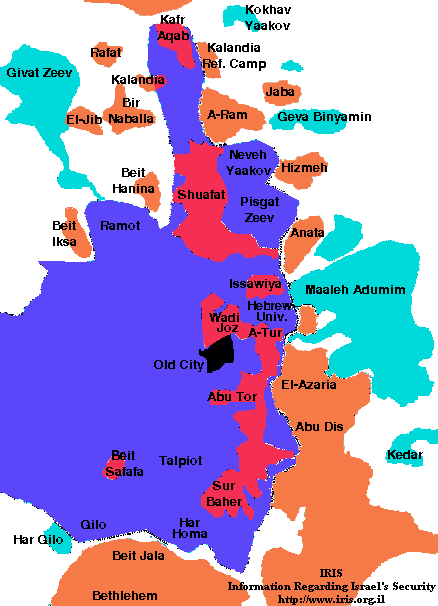| Please share this page: |
Barak's Proposal to Divide Jerusalem
The map below is based on one which appeared in the Israel daily newspaper Maariv on July 27, 2000, just after the conclusion of the Camp David talks on the Israeli-Palestinian final status agreement.
According to the accompanying article by reporter Ben Caspit, Israeli negotiators under Prime Minister Ehud Barakk for the first time proposed to divide Jerusalem into two cities: a Jewish city to be known as Jerusalem which would serve as Israel's capital, as it does now; and an Arab city to be known as Al-Quds, the Arabic name for Jerusalem, which would serve as the capital of a new Palestinian Arab state. This is the first time any Israeli prime minister had even suggested dividing Israel's capital since the city was reunified under Israeli rule after the 1967 Six Day War. Mr. Barak himself ran for office just a year before on a platform emphasizing his commitment to a united Jerusalem.
The Israeli proposal included the following main points:
1. Jewish areas outside Jerusalem's municipal boundaries would be annexed to the city, including such population centers as Givat Ze'ev, Ma'aleh Adumim and Gush Etzion. (Gush Etzion is a major settlement block just south of Jerusalem, and is not shown on the map).
2. Arab areas outside Jerusalem's municipal boundaries would become the heart of the new Arab city of Al-Quds, including regions such as Abu Dis, el-Azaria, Beit Jala, Anata and A-Ram.
3. Arab neighborhoods inside Jerusalem's present boundaries would either be annexed to Al-Quds or would be granted extensive self-rule. Though some of these areas would remain formally under Israeli sovereignty, in practice Israel would have little authority over them.
4. Jerusalem's ancient, walled Old City would be divided, with the Muslim and Christian quarters offered autonomy under formal Israeli sovereignty, while the Jewish and Armenian quarters remained fully under Israeli rule. The Palestinian state would gain religious autonomy over the Temple Mount, though Israel proposed that an area be set aside for Jewish prayer on the site.
This unprecedented proposal was nonetheless rejected by the Palestinian side, who demanded full sovereignty over all of Jerusalem's Arab neighborhoods. An American compromise proposal granting them sovereignty over the Old City neighborhoods but autonomy over the city's other Arab neighborhoods, or vice versa, was also soundly rejected, though the Israeli side had indicated its readiness to consider this as well.

LEGEND |
|
 |
Jerusalem: Present municipal boundaries |
 |
Jewish areas to be annexed to Jerusalem |
 |
Arab neighborhoods of Jerusalem to be ceded to Al-Quds |
 |
Arab areas outside Jerusalem to be designated Al-Quds |
 |
Jerusalem's Old City: to be divided between Jerusalem and Al-Quds |
Aside from the questions of principle, the details of the proposal appear unworkable in the extreme. There are numerous enclaves linked or separated by narrow strips of territory or by restricted access roads, and a patchwork of different sovereignties and levels of jurisdiction.
The plan would carry a high price tag in order to allow for the construction of the various tunnels, bridges and bypass roads needed to connect the various pieces of the respective cities. But further, even with the best of goodwill from all it would be a certain cause of strife as residents of each side came in close contact with each other while operating under different sovereignties and legal systems. The plan therefore made a mockery of the Left's proposed "separation" of Jews and Arabs as a way to end the conflict between them.
Shortly after this offer was made the Second Intifada broke out, which included shootings from Palestinian-controlled Beit Jala against the Jerusalem neighborhood of Gilo. This showed the danger of allowing Arab control of areas bordering where Jewish civilians live. Dividing Jerusalem would have created potential Gilos throughout much of the city.
Finally, the plan would likely tear Israeli society apart. The dream of a united Jerusalem under Jewish sovereignty is one of the main bases of modern Zionism. Further, the Temple Mount (which would fall under Arab sovereignty as described above) is Judaism's holiest place and the center of Jewish longing for the return to the Land of Israel for almost 2000 years. The renunciation of the political and spiritual foundations of the Jewish state and religion would not only be unparalleled in history, but also would likely arouse tremendous resistance from most Jews in Israel and perhaps around the world.

News you can use from Israel.
Join our Free mailing list!
Home Israel Blog Disengagement Terror Charts Security Maps Israel Size Maps PLO Background PLO Quote Sheets Did Israel Offer Too Much? About IRIS Contact Us Web links